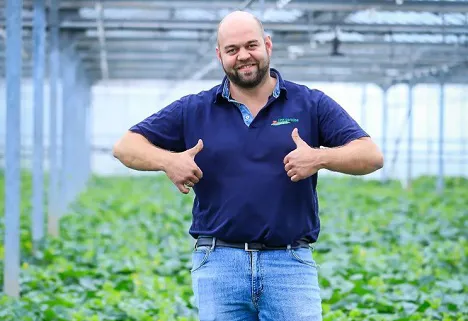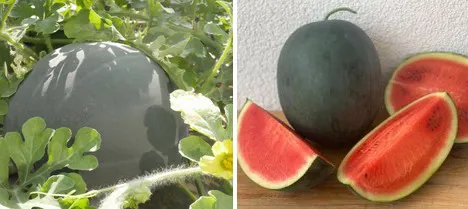Since the end of June, the Link family's melon greenhouse in the heart of Nuremberg's Knoblauchsland region has been bustling with activity. For the third year in a row, the vegetable farm is involved in the cultivation and marketing of watermelons. And not without success, owner Stefan Link says in an interview. Because in order to meet the growing demand in the future, they will also cultivate watermelons in the open field next year.

Stefan Link has been dedicated to the production of melons for about three years. This produce will be harvested by the end of the month.
Due to labor shortages and intensive specialty crop cultivation, Link tried his hand at producing the tropical fruit three years ago. "We were having increasing trouble finding the labor we needed for our labor-intensive greenhouse crops, such as cucumbers, tomatoes, and iceberg lettuce, and then looked for a lower-maintenance crop. So we then planted our first watermelons in our greenhouse in 2019," Link says, looking back. In addition to the watermelons (about 70%), the range has since been expanded to include cantaloupes.
 At weekly markets, smaller products (1.5-2 kg) are particularly popular because the product can no longer be sold in cut form. In the specialized retail trade, on the other hand, melon pieces are still offered, which is why the large-caliber product (approx. 3.5 kg) is particularly popular.
At weekly markets, smaller products (1.5-2 kg) are particularly popular because the product can no longer be sold in cut form. In the specialized retail trade, on the other hand, melon pieces are still offered, which is why the large-caliber product (approx. 3.5 kg) is particularly popular.
Minimal labor input
This year's yield is below last year's level, but demand is slightly higher this year, he said. Link: "We market our melons primarily through our stand sales at the local wholesale market, with the remainder distributed either directly to the food service industry or through the farm store. The net revenue per square meter is lower compared to local crops, but the labor required is minimal, which is why the cultivation is clearly profitable - especially in view of the increasing demand." Compared to imported products, the price difference is minimal, according to Link.
Growing melons outdoors
Based on the positive results, Link has decided to grow open-ground melons for the first time next year. "We initially refrained from growing outdoors in 2019 because these fruits are only harvested from August, by which time the main season usually comes to an end. However, if we seamlessly launch into the open ground season after the greenhouse harvest is finished, the marketing window, on the other hand, would be considerably longer, and it would therefore be more interesting for the buyer to offer German melons. I wouldn't even rule out the possibility that the southern German melons could also be listed in food retail in the long term," Link concludes.
For more information:
Stefan Link
Link Gemüse und Früchte GmbH & Co. KG
Am Wegfeld 21
90427 Nürnberg
Tel.: 0911/38 11 84
info@link-gemuese.de
link-gemuese.de/
